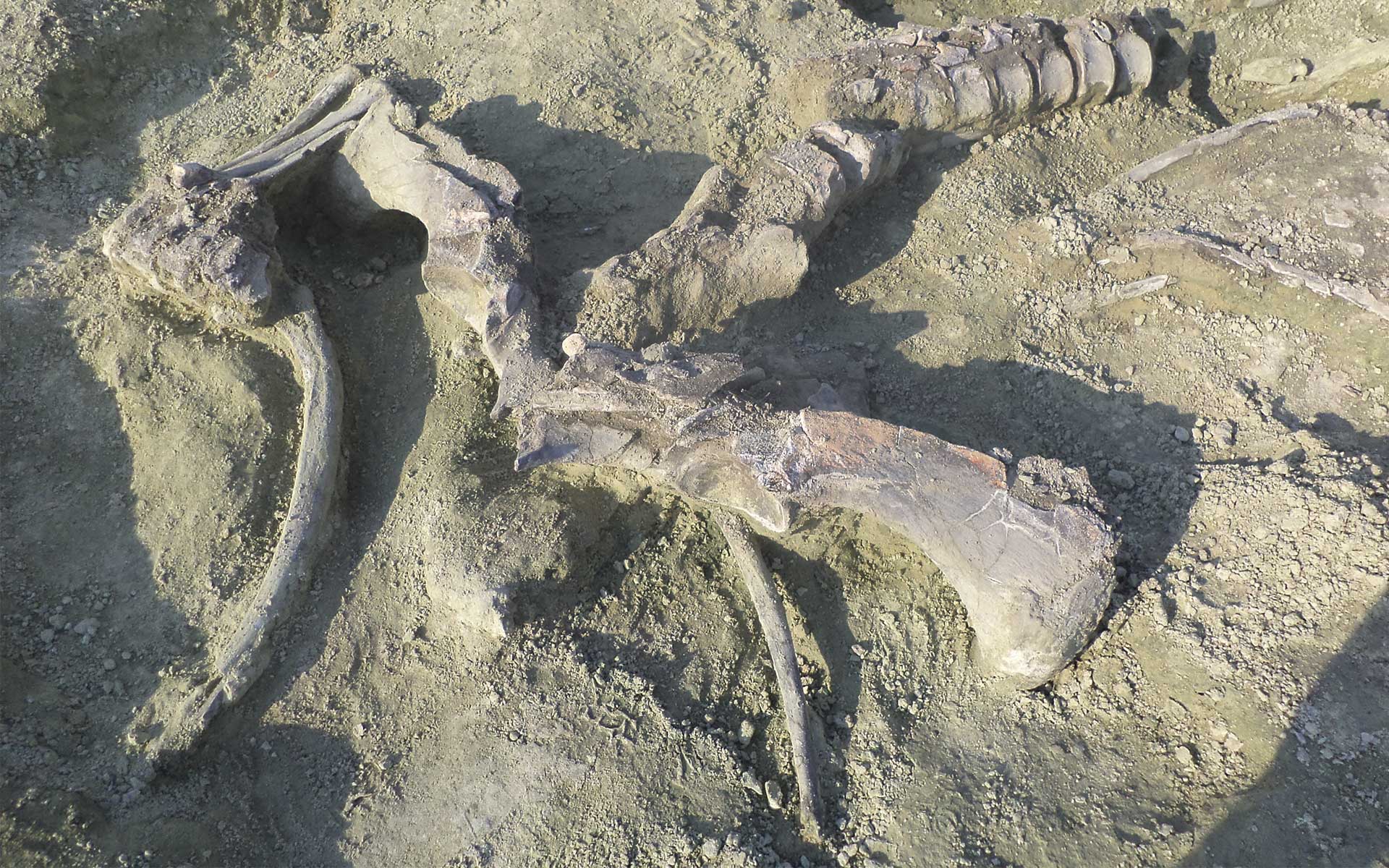
Panorama of the Etosha Pan.
Geological Period
Miocene to Pleistocene
Main geological interest
Stratigraphy and sedimentology
Geomorphology and active geological processes
Paleontology
Location
Oshikoto and Oshana Regions, Namibia
18°46’00”S, 016°22’00”E
Panorama of the Etosha Pan.
One of the largest palaeolake salt pans in the world, which supported a diverse Neogene to Pleistocene fossil fauna.
The extensive Kalahari Supergroup is a key component of the geology of Central and Southern Africa. Consisting of unconsolidated to calcrete-cemented fluvial, pedogenic and aeolian sediments, it is poorly understood and difficult to date. Fossils discovered by Hipondoka (2005) and studied by Miller et al. (2010) and Pickford et al. (2016), together with the geomorphological evolution of Etosha Pan recorded by Buch and Rose (1996) and Buch et al. (1992), have highlighted for the first time the late-stage evolution of the upper Kalahari through alternating periods of seasonal rainfall and hyper-aridity that match palaeoclimate records from East Africa (DeMenocal, 2004).
- Geological description
The Etosha Pan was a Neogene, saline palaeolake at the endpoint of Angolan-sourced Cubango Megafan (Hipondoka, 2005; Buch and Rose, 1996; Miller et al., 2010) and the Cuvelai-Ekuma River System. Alternate flooding and desiccation occurred under semi-arid climatic conditions. Green, analcime-bearing clays of the Etosha Pan Clay Member formed the palaeolake bed. Fossils in interfingering sandstones include 4 – 6 million-year-old plants, invertebrates, birds, bovids, mammoth, white rhinoceros, crocodiles, hippopotamae, carnivores, turtles and fish. The fresh-water aquatic and riparian fossils were washed down the Ekuma River. The saline conditions supported flamingo populations. Arid conditions set in at about 4 Ma. Both river systems ceased to flow but palygorskite-bearing calcrete started to spread northwards over the lake bed clays. This calcrete was deposited by hard water sourced from highly karsted Neoproterozoic mountains south of the pan. Arid conditions prevailed for about 3 million years after which the cycle of flooding and desiccation resumed. Salt fragmented the calcrete. Deflation by easterly winds inverted the palaeolake stratigraphy in lunette dunes that accumulated along the western margin of the pan by first excavating the palygorskite-bearing calcrete then the analcime-bearing clays. Groundwater seeps support vibrant wildlife that is Namibia’s main tourist attraction.
- Scientific research and tradition
The Etosha Pan has been studied since the 1920s until present. Two schools of thought persisted for some time, one of which was that the pan had a standing lake. Much research has been done on its geomorphology (Hipondoka, 2005), geology (Miller, et al., 2010) and palaeontology (Pickford et al., 2016).
- Reference
Buch, M.W. and Rose, D. (1996) ‘Mineralogy and geochemistry of the sediments of the Etosha Pan Region in northern Namibia: a reconstruction of the depositional environment’, Journal of African Earth Sciences, 22(3), pp. 355–378. Available at: https://doi.org/10.1016/0899-5362(96)00020-6.
Buch, M.W., Rose, D. and Zöller, L. (1992) ‘A TL-calibrated pedostratigraphy of the western lunette dunes of Etosha Pan/northern Namibia: Palaeoenvironmental implications for the last 140ka’, in K. Heine (ed.) Palaeoecology of Africa and the sourrunding islands, pp. 129–147.
deMenocal, P.B. (2004) ‘African climate change and faunal evolution during the Pliocene–Pleistocene’, Earth and Planetary Science Letters, 220(1), pp. 3–24. Available at: https://doi.org/10.1016/S0012-821X(04)00003-2.
Hipondoka, M. (2005) The development and evolution of Etosha Pan, Namibia, https://opus.bibliothek.uni-wuerzburg.de/opus4-wuerzburg/frontdoor/index/index/docId/1195. Thesis. University of Wurzburg. Available at: https://repository.unam.edu.na/handle/11070/1784.
Miller, R.M., Pickford, M. and Senut, B. (2010) ‘The geology, palaeontology and evolution of the Etosha Pan, Namibia : implications for terminal Kalahari deposition.’, South African Journal of Geology, 113(3), pp. 307–334. Available at: https://doi.org/10.2113/gssajg.113.3.307.
Pickford, M. et al. (2019) ‘Update of the Pliocene fauna of the Ekuma Valley, Etosha, Namibia.’, Communications of the Geological Survey of Namibia, 17, pp. 113–142.
- Author(s)
Helke Mocke.
Geological Survey of Namibia, Namibia.
Roy McG. Miller.
Consulting Geologist.
Martin Hipondoka.
University of Namibia.
Martin Pickford.
Muséum National d’Histoire Naturelle. France.
Brigitte Senut.
Natural History Museum, Paris. France.
Loïc Ségalen.
Sorbonne University, Paris. France.


